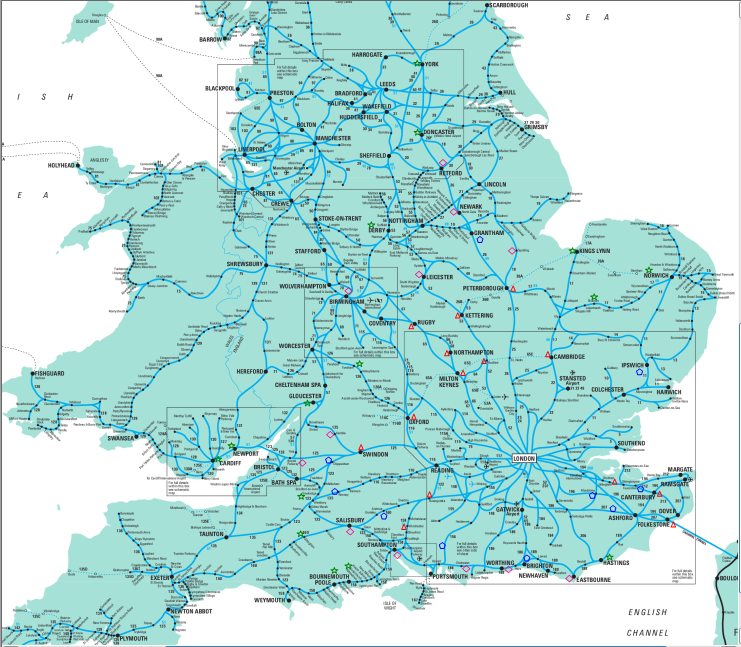A rail map for supercommuters: lower cost houses within 2 hours of London, for semi-regular long range commutes
by LB • December 28, 2016 • commuting, EWS, feature, house prices, property, super commuting • 0 Comments
Here is a railway route map for supercommuters: a selection of over 50 railway stations, categorized by approximate journey times to central London.
Maybe you don’t have to work in London or the South East every day. Maybe you can do work there part of the week, so that your commute is not daily, but, say, twice a week. Or perhaps you travel there and stay there for work for two or three days, so that one return journey, one long range commute, or supercommute, per week is all you need.
This arrangement means you can take advantage of the work opportunities in the South East, and the higher pay rates sometimes available there, while your main living base is in a much lower cost area.
Key: a green star denotes a journey time to central London of around 2 hours. A pink diamond denotes journey times around 1.5 hours. A blue pentagon denotes journeys around 1.25 hours. A red triangle denotes journeys of around 1 hour.
The east coast main line, London to Edinburgh, remains one of the straightest and fastest rail lines in the country. You can go as far north as York and still be within approximately 2 hours to London.
On this line, there is plenty of very good value housing, especially semis with lots of room and large gardens, in the areas around Newark and Spalding, with journey times to central London around 90 minutes. Grantham is a quarter of an hour closer. If you have business or personal connections in the north east or Edinburgh then these would be convenient locations with fast journey times north as well as south. Also, there are comparatively reasonable fares available on this rail line. Services are reliable. Further north on the line, Doncaster and surrounds offer some cheap property; you have to search out the best localities and neighbourhoods.
Peterborough, Kettering and Rugby all offer 1 hour journey times to London and there are possibilities for lower cost housing within range of these places.
The Great Western line brings Cardiff and Newport within 2 hours’ range of central London. The valleys north of Cardiff and the area around Newport offer some low cost housing, although it is mainly terraced and you have to search harder for semi-detached and detached with gardens or land. Some of the towns and villages in these areas feel less post-industrial than others, so you have to search out better and more attractive towns and districts. There has been lots of regeneration in Cardiff and also, on a smaller scale, in Newport. There are some local train services around Cardiff that connect you to main line trains at Cardiff Central. One problem is high train fares – fares have gone up a lot on the Great Western line, and it is hard to find reasonable fares at any time of day. This also affects stations and areas closer to London, such as Swindon.
South of London, there is some cheaper property in and around Folkestone. Faster Euro trains have cut journey times to London. However, you pay premium fares for the fast services. Not much downshifting property in this south and south east region which is traditional daily commuter territory. Also, the central part of this area is served by unreliable Southern Rail.
There are some very nice and scenic spots in North Norfolk, within range of King’s Lynn which offers a 2 hour journey to London. Housing prices are not particularly cheap, however. The value stuff is further west, in the Fens, closer to Spalding station with its faster journey times.
Bedford and Northampton are unfashionable and the property market is worth looking at for value. One hour journey times make daily commuting to London feasible, but they have never been popular choices for ordinary commuters. There are attractive aspects to Bedford with riverside parks and some decent traditional houses. Nearby smaller towns such as Sandy are unglamorous but quite cheap and practical. However, roads around Bedford can be congested – especially the link road to the M1. Northampton is busy with industrial estates and the various ring roads and expressways get clogged at peak times.
Further north, Derby offers a 2 hour journey time to London, and the city and its more rural surrounds offer some good quality houses at reasonable prices. There has been some regeneration in the city centre and there are things to do; older streets in the centre are grittier. Roads around Derby are not too congested and there is a fast link to the M1.
One interesting aspect of this: if an approximate 2 hour journey time to central London is set as the limit for a semi-regular commute to the capital, then large areas of otherwise promising downshifting territory are excluded from consideration. Areas of low housing costs on the east coast around Hull, Grimsby, Scarborough are too remote from the main line stations and are out of range. Locations north of Manchester such as Halifax or Preston are just too far away. The entirety of Wales, beyond those south Wales valleys and the Cardiff and Newport areas, is out of consideration, too remote from London and the south east. This last one is frustrating – there are attractive locations and properties with potential north and west of Swansea – but if 2 hours is the limit and you need to maintain contact with London, then this area is just a bit too far from the centre of things.

